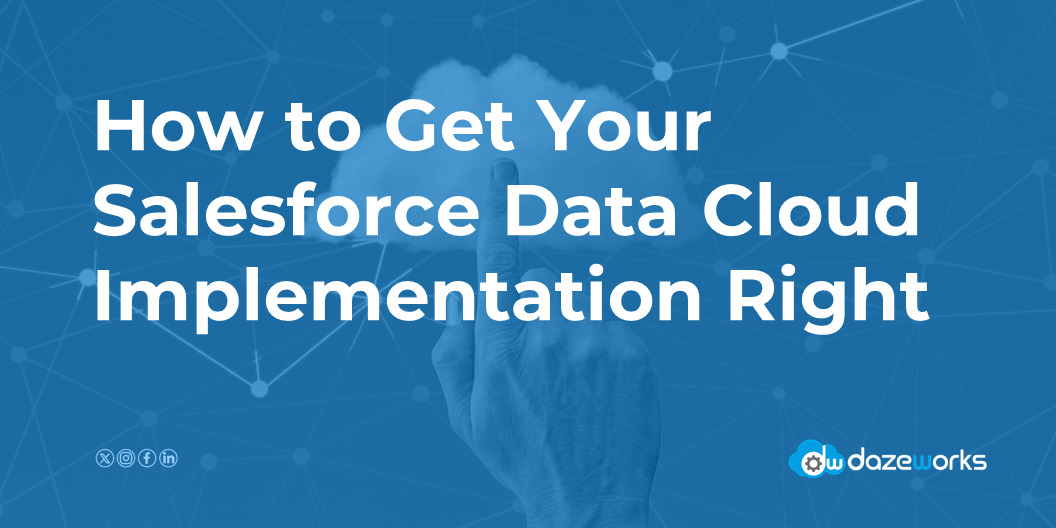
How to Get Your Salesforce Data Cloud Implementation Right?
minutes read
Salesforce Data Cloud is an innovative platform that can potentially revolutionize how organizations manage, analyze, and leverage their data. Its implementation is a comprehensive process that requires you to cater to different criteria. In this comprehensive guide, we will walk you through the key steps to successfully implement Salesforce Data Cloud and unlock its full potential for your business.
Why Do You Need Salesforce Data Cloud?
- Improved Data Visibility and Accessibility: Gain a single, holistic view of your data, making it easier to access, analyze, and derive valuable insights.
- Enhanced Data-Driven Decision Making: Leverage real-time and advanced analytics to make more informed, data-driven decisions that drive business growth.
- Streamlined Data Governance and Compliance: Implement robust data governance policies and ensure compliance with industry regulations, mitigating risks and maintaining data integrity.
- Foster Collaboration and Productivity: Empower your teams to collaborate seamlessly and work more efficiently by providing them with a centralized data platform.
- Unlock New Revenue Streams: Leverage your data to identify new market opportunities, develop innovative products or services, and drive revenue growth.
What are the Key Components of Salesforce Data Cloud?
- Salesforce Einstein Analytics: A powerful AI-powered analytics tool that enables you to uncover insights, predict trends, and make data-driven decisions.
- Salesforce Data Management: Provides a centralized data hub for integrating, cleansing, and governing your data from various sources.
- Salesforce Data Pipelines: Facilitates seamless data flow between Salesforce and external systems, ensuring up-to-date and readily available data.
- Salesforce Data Stewardship: Empowers your team to manage data quality, metadata, and data lineage, ensuring data integrity and compliance.
- Salesforce Data Security: Offers robust security measures to protect your data, including access controls, encryption, and audit trails.
Step-by-Step Guide to Implementing Salesforce Data Cloud
Assess Your Data Landscape
Conduct a thorough audit of your existing data sources, systems, and processes to understand the current state of your data infrastructure. Clearly articulate the key business goals and use cases that you aim to address with Salesforce Data Cloud, ensuring alignment with your overall strategic priorities.
Develop a Data Integration and Preparation Strategy
Identify the data sources you need to integrate and create a data cleansing, transformation, and enrichment plan to ensure data quality and consistency. Implement policies, processes, and roles to manage data ownership, access, and security, ensuring compliance and mitigating risks. Leverage the platform’s features and capabilities to set up data integration, analytics, and reporting based on your specific requirements.
Test and Train the Process
Conduct thorough testing to ensure the platform is functioning as expected and make any necessary adjustments before the full rollout. Provide comprehensive training to your teams, equipping them with the knowledge and skills to effectively utilize Salesforce Data Cloud and drive adoption.
Monitor and Optimize Performance
Continuously monitor the platform’s performance, identify areas for improvement, and adjust and optimize the overall efficiency and effectiveness of your Salesforce Data Cloud implementation.
Best Practices for Data Governance in Salesforce Data Cloud
- Define Data Ownership and Accountability: Identify data owners and their responsibilities for maintaining data quality, security, and compliance.
- Implement Data Stewardship Processes: Establish data stewardship roles and processes to ensure data is properly managed, monitored, and maintained.
- Develop Data Policies and Standards: Create comprehensive data policies, guidelines, and standards to govern data usage, access, and security across your organization.
- Automate Data Quality Monitoring: Leverage Salesforce Data Cloud’s built-in data quality tools to continuously monitor and address data quality issues.
- Ensure Compliance and Regulatory Adherence: Align your data governance practices with relevant industry regulations and compliance requirements to mitigate risks.
Data Security and Privacy Considerations in Salesforce Data Cloud Implementation
- User Access and Authentication: Implement robust access controls, multi-factor authentication, and role-based permissions to ensure that only authorized users can access and manipulate data.
- Data Encryption and Masking: Leverage Salesforce Data Cloud’s encryption capabilities to protect sensitive data and consider data masking techniques to further enhance privacy.
- Audit Trails and Logging: Enable comprehensive audit trails and logging to monitor data access, changes, and activities, ensuring transparency and compliance.
- Disaster Recovery and Business Continuity: Develop a robust disaster recovery plan and backup strategy to ensure the availability and resilience of your Salesforce Data Cloud implementation.
- Regulatory Compliance: Ensure your Salesforce Data Cloud implementation aligns with relevant data privacy regulations, such as GDPR, HIPAA, or CCPA, to mitigate legal and reputational risks.
Monitoring and Optimizing Salesforce Data Cloud Performance
- Establish Performance Metrics: Define a set of Key Performance Indicators (KPIs) to track the efficiency, effectiveness, and user adoption of your Salesforce Data Cloud implementation.
- Implement Monitoring and Alerting: Leverage Salesforce Data Cloud’s built-in monitoring tools and set up alerts to proactively identify and address any performance issues or bottlenecks.
- Analyze Usage and Adoption Patterns: Regularly review user activity, data access patterns, and adoption trends to identify areas for improvement and optimize the platform’s configuration.
- Optimize Data Pipelines and Workflows: Continuously review and refine your data integration and preparation processes to ensure they remain efficient and scalable.
- Leverage Salesforce Einstein Analytics: Utilize the advanced analytics capabilities of Salesforce Einstein Analytics to gain deeper insights into your Salesforce Data Cloud performance and identify optimization opportunities.
Conclusion
Salesforce Data Cloud is a powerful platform that can revolutionize the way your organization manages, analyzes, and leverages its data. By following the step-by-step guide outlined in this article and implementing best practices for data governance, security, and performance optimization, you can unlock the full potential of Salesforce Data Cloud and drive tangible business results.
To learn more about how Salesforce Data Cloud can transform your organization, schedule a consultation with our team of Salesforce experts. We’ll work with you to assess your data landscape, define your business objectives, and develop a customized implementation plan that aligns with your unique needs. Contact us today to get started!
